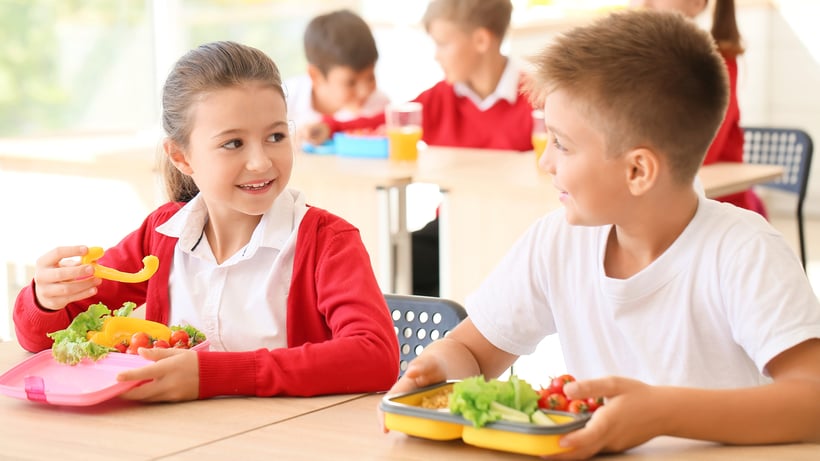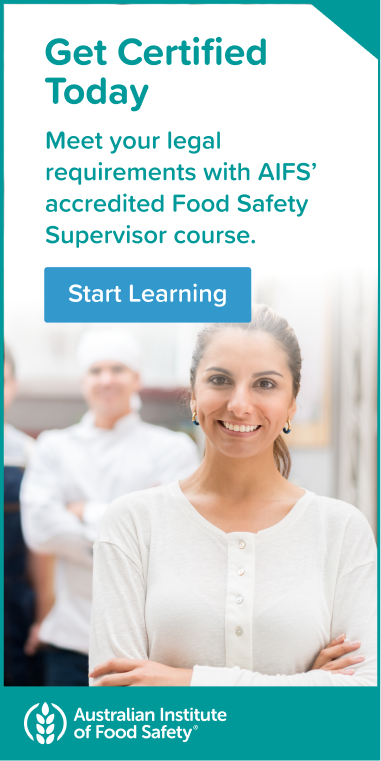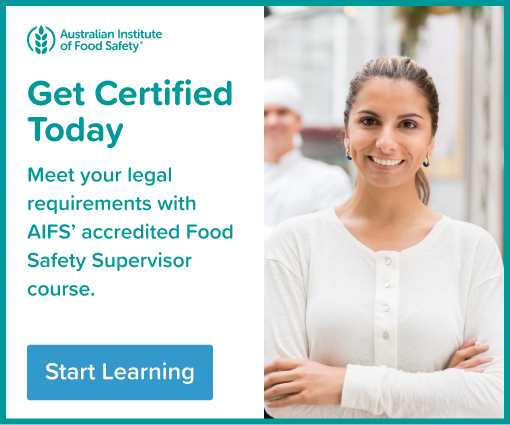
As the new school year begins, parents, teachers and school canteen staff have one shared priority—ensuring children stay safe.
Keeping school lunches fresh and free from contamination is essential to minimising the risk of food-borne illnesses. In this blog, we will share essential school food safety tips and highlight the importance of Food Handler training.
Whether you are an employee or volunteer serving food in a school canteen, or a parent preparing lunches, the start of the school year is the ideal time to focus on achieving food safety excellence.
Contents:
Why school food safety matters
School canteen food safety tips
Building a Culture of food Safety
The role of Food Handler training in schools
AIFS Food Handler Course for schools
Why school food safety matters
Every year, millions of Australians suffer from food-borne illnesses, many of which could have been prevented with proper food safety practices. In a school setting, where children may have weaker immune systems, the risks are even greater.
Additionally, the prevalence of food-borne illness cases tends to rise during the summer months, as higher temperatures create an ideal environment for harmful bacteria to grow. This is why implementing effective food safety practices at the start of the school year is essential to ensure that the food served to children is safe to eat.
Contaminated food can lead to illnesses caused by bacteria like E. coli, Salmonella and Listeria, resulting in missed school days and, in severe cases, hospitalisation.
Packed lunch safety tips
For parents or guardians, it is vital that the following steps are taken to ensure children’s packed lunches are safe for consumption.
1. Follow safe food preparation procedures
The implementation of effective food preparation methods is the first step to ensuring meals are safe and free from contamination. Follow these essential practices:
- Wash hands thoroughly before starting to prepare food.
- Clean and sanitise equipment, utensils and surfaces before and after preparing food.
- Use separate chopping boards for raw and ready-to-eat foods to prevent cross-contamination.
2. Choose the right ingredients
When preparing school lunches, start with fresh, high-quality ingredients. Avoid items that spoil quickly, such as mayonnaise-based salads, rice or raw seafood, unless proper refrigeration is guaranteed.
- Opt for fruits and vegetables that can be washed thoroughly.
- Include non-perishable snacks like wholegrain crackers or sealed yoghurt pouches.
- Choose lower-risk foods (e.g. consider swapping a milk-based drink for a packaged fruit juice, which has a longer shelf life and is less prone to bacterial growth).
3. Keep lunches cool
Temperature control is a critical component of food safety. Perishable items must be kept at safe temperatures to prevent bacterial growth.
- Use insulated lunchboxes with ice packs to keep chilled food below 5°C.
- Pack drinks that can double as coolers, such as frozen water bottles or a juice box.
- Remind children to store their lunchboxes in cool, shaded areas if refrigeration is unavailable.
4. Separate foods to avoid cross-contamination
Cross-contamination can occur when raw and cooked foods come into contact with each other. To prevent this:
- Use separate containers for lunch items from different food groups
- Wrap sandwiches individually to avoid moisture from other items.
- Ensure that reusable containers are washed thoroughly with hot, soapy water after each use.
4. Emphasise hand hygiene
Good hygiene begins with clean hands. Before handling food, wash hands with soap and water for at least 20 seconds.
- Encourage children to wash their hands before eating.
- Provide hand sanitisers in lunchboxes as an added precaution.
Common Mistakes to Avoid
Even with the best intentions, mistakes can happen. Here are a few to watch out for:
- Leaving perishable items out of refrigeration for extended periods.
- Relying on reusable ice packs without ensuring they are fully frozen.
- Overpacking lunchboxes, which can limit airflow and keep foods from staying cool.
- Ignoring allergy risks by failing to label or separate allergen-containing foods.
School canteen food safety tips
Maintaining food safety in school canteens is vital to protect the health of students. Follow these key practices to ensure safe and nutritious meals are served:
1. Follow safe food preparation procedures
Effective food preparation methods are the foundation of food safety in any kitchen. Implement these essential steps:
- Ensure all food preparation surfaces, utensils and equipment are cleaned and sanitised regularly.
- Use fresh, high-quality ingredients and discard food items that are past their expiration date.
- Prepare food in carefully planned batches to minimise the risk of contamination and ensure freshness.
- Encourage staff and volunteers to engage in food safety training courses.
2. Avoid cross-contamination
Preventing cross-contamination is crucial to maintaining food safety and avoiding the spread of harmful pathogens. To achieve this:
- Use separate chopping boards and utensils for raw and ready-to-eat foods.
- Store raw meats and seafood below ready-to-eat items in refrigerators to prevent drips.
- Package and label food items clearly to avoid mixing ingredients with allergens.
- Regularly sanitise reusable food containers, trays and serving equipment.
3. Inspect and rotate stock
Keeping food supplies safe and organised helps prevent spoilage and wastage. Ensure stock is well-maintained by:
- Purchasing food products from reputable suppliers.
- Regularly inspecting all food supplies for damage, spoilage or expired products.
- Implementing a "First In, First Out" (FIFO) system to ensure older stock is used first.
- Storing perishable items in refrigerators set to 5°C or below.
- Performing routine cleaning and maintenance of refrigeration units, ovens and other kitchen equipment to maintain proper functionality.
4. Keeping lunches warm
School canteens typically keep food warm after cooking so that it can be served to a large number of people over an extended period of time. To do this safely, canteen staff must:
- Keep hot foods at or above 60°C to prevent bacterial growth.
- Use equipment designed for hot holding, such as bain-maries or heated cabinets.
- Monitor food temperatures with a calibrated thermometer to ensure compliance with food safety standards.
- Discard any hot food that has been held below 60°C for more than two hours.
5. Maintain hand hygiene standards
Good hand hygiene is critical to preventing food-borne illnesses and maintaining a safe kitchen environment. Follow these practices:
- Establish hand washing protocols for all canteen staff, including washing hands with soap and water for at least 20 seconds before handling food.
- Provide hand washing stations equipped with soap, water, and disposable paper towels or air dryers.
- Ensure staff wear gloves when handling ready-to-eat food and replace them regularly.
- Display posters to remind staff and students of the importance of good hand hygiene.
Building a Culture of food safety
Food safety and hygiene is a shared responsibility. Here’s how parents, schools and canteen staff can work together:
Parents:
- Follow safe food preparation guidelines at home.
- Teach children how to maintain hygiene standards.
Schools:
- Educate students about safe eating practices, such as washing hands before meals.
- Provide hand sanitisers at key locations, such as canteen counters or communal eating areas.
- Implement and follow a food safety plan, including regular audits and inspections.
- Provide training on food safety and allergen management.
The role of Food Handler training in schools
Approximately 4.7 million cases of food-borne illness are reported each year in Australia, resulting in 47,900 hospitalisations and 38 deaths.
These statistics highlight how important it is for Food Handlers to understand the various causes of food-borne illnesses and the steps needed to prevent them.
Food Standards Australia New Zealand (FSANZ) sets consistent food safety regulations across Australia, including Standard 3.2.2A, which mandates training for anyone involved in handling, preparing, or serving food as part of their role.
Schools have a responsibility to ensure that food handling staff are adequately trained. School Food Handler training provides employees with the knowledge and skills required to maintain high standards of hygiene and safety.
By investing in Food Handler training for schools, institutions can build trust with parents and create a safer environment for students.
AIFS Food Handler Course for schools
The Australian Institute of Food Safety (AIFS) is approved to deliver a nationally recognised Food Handler course that covers the specific units of competency required for schools. The applicable unit depends on the state or territory and will typically be one of the following:
- Hospitality: SITXFSA005 - Use Hygienic Practices for Food Safety
- Health & Community: HLTFSE001 - Follow Basic Food Safety Practices
The AIFS Food Handler course provides school Food Handlers with a solid understanding of key food safety principles, enabling them to perform their duties safely and responsibly.
Here are some of the key topics covered during this online training program:
- Cleaning & Sanitising
- Food Allergies & Allergen Management
- Food Contamination
- Food Safety Laws & Responsibilities
- Food Safety Programs
- Hand Washing
- Identifying Food Safety Hazards
- Personal Hygiene & Workplace Behaviour
- Receiving & Storing Food
- Serving Food Safely
- Time & Temperature Control
- Working with Food Safely
Enrol in the AIFS Food Handler Course today!
Understanding and practising food safety is crucial for staff, volunteers, parents and guardians involved in preparing, handling and serving school lunches. Fortunately, professional Food Handler training is available to help you meet food safety obligations and reduce the risk of food-borne illness.
Start the school year on the right note. Enrol in the AIFS Food Handler Course today and make school lunches safer for everyone.




